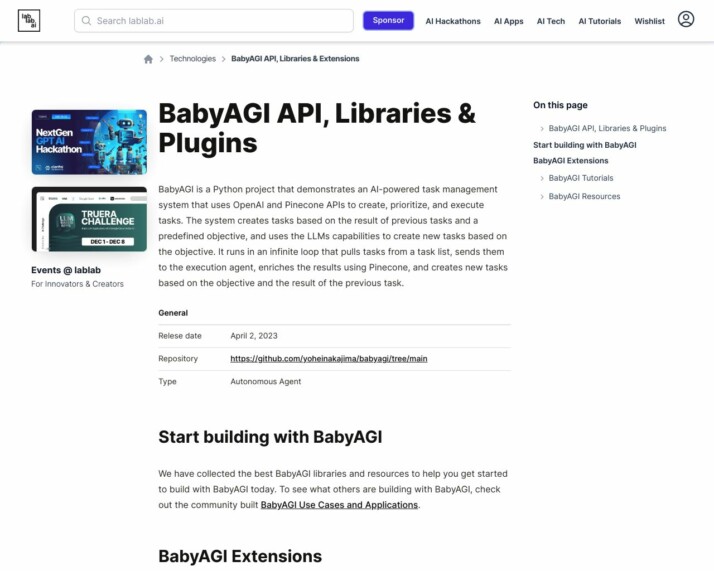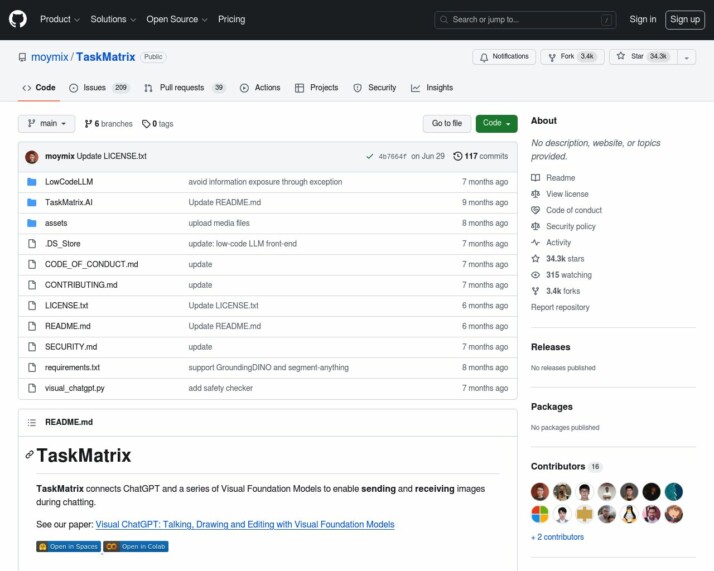Introduction
BabyAGI vs TaskMatrix are two popular AI assistant platforms that we will explore in-depth. By comparing their key features, capabilities, target audience, and integration possibilities, you will be able to choose the platform that best suits your specific needs.
BabyAGI has been developed and deployed to automate various tasks using AI. With the use of advanced technologies like GPT-4 and a vector search engine, BabyAGI demonstrates broad applicability in problem-solving and information retrieval areas. It aims to ease the burden of task management by efficiently handling routine and complex tasks through advanced language processing and search capabilities.
On the other hand, TaskMatrix.AI offers a unique and accessible approach to AI development. With a no-code interface, users can build and customize AI apps without requiring programming or machine learning expertise. The platform allows for personalized, context-aware AI apps, enabling tailored responses and functionalities to individual user needs. TaskMatrix.AI also emphasizes explainability and transparency, providing feedback mechanisms for API developers.
Both platforms cater to a wide audience, from business professionals seeking efficient task management to individuals and industries with complex information processing needs.
BabyAGI is suitable for autonomous task generation and execution, making it valuable for business professionals, developers, and individuals seeking personalized AI assistants. TaskMatrix.AI appeals to both technical and non-technical professionals interested in leveraging AI for personal or innovative applications, with its emphasis on personalization and no-code AI creation.
By understanding the unique features and target audience of each platform, you will be able to make an informed decision and choose the AI assistant platform that aligns with your goals. Let’s dive deeper into the comparison between BabyAGI and TaskMatrix.AI to help you make the right choice.
An In-Depth Overview of BabyAGI


For professionals in need of a solution that can autonomously execute complex tasks, BabyAGI stands out. It operates by combining advanced language processing with an intuitive search engine, making it capable of solving problems and retrieving information. Developed and deployed, BabyAGI is a significant leap in AI-driven automation. Therefore, if you’re weighing up the options – Alternative to BabyAGI or TaskMatrix, this autonomous agent might be an ideal fit for your needs.
BabyAGI is not a no-code solution, and it does require an understanding of coding and command line operations. Its setup integrates with OpenAI’s API, more specifically the Large Language Model (LLM) known as GPT-4, and Pinecone, a vector database server. Although it necessitates technical proficiency, it allows user to set up tasks and objectives, enabling hassle-free interaction with AI.
- BabyAGI versus TaskMatrix features: While BabyAGI lacks cloud-based hosting for development and production environments, it excels in its ability to remember past interactions and utilise this data to enhance ongoing processes. On the other hand, TaskMatrix may still have the upper hand in terms of having a visual builder and debug mode.
- BabyAGI performance comparison: Envisioned to lighten the burden of task management, BabyAGI triumphs in handling tedious chores, data analysis, and problem-solving. However, it does not support the analysis and processing of text files nor is presented as a personal assistant programme.
When considering sectors with sophisticated data processing needs, such as legal, financial, or healthcare industries, BabyAGI showcases its true potential. It can swiftly sift through large volumes of data and extract pertinent information. As such, for companies and individuals seeking a revolutionary, AI-driven solution for task management, BabyAGI is a choice worth considering.
An Overview of TaskMatrix
TaskMatrix is a unique AI platform which performs a variety of complex tasks across multiple domains. This user-friendly platform uses a special Large Language Model (LLM), called the Multimodal Conversational Foundation Model (MCFM), to understand user instructions in various formats and generate executable code. This makes TaskMatrix an interesting alternative to other AI platforms.
One of the notable features of TaskMatrix is its use of reinforcement learning with human feedback (RLHF) to optimize its models. This means it uses human insights to enhance its performance and improve AI interactions.
The audience for TaskMatrix is diverse, providing a range of comprehensive AI functionalities. It caters to developers and engineers, business professionals, product managers, IoT enthusiasts, educators, and more. It’s even a valuable tool for end users seeking personalized AI assistance.
TaskMatrix is suitable for automating a variety of tasks including office automation, utilization of cloud services, and controlling robotics and IoT devices. Its architecture includes an API platform for storing and managing APIs, an API selector for choosing the most suitable APIs for tasks, and an action executor for running the APIs. This makes TaskMatrix a strong contender when you compare it to other AI platforms like BabyAGI.
The company’s vision is to create an AI system that can smoothly interact with both the digital and physical world, making it a versatile tool for a wide range of applications. This ambition to integrate AI more deeply into everyday tasks positions TaskMatrix as a forward-thinking player in the AI space.


Detailed Feature Comparison: BabyAGI vs TaskMatrix
Welcome to our comprehensive feature comparison between BabyAGI and TaskMatrix. In this section, we explore the strength and weakness of each platform. We’ve simplified the information to help you understand which platform best suits your needs.
| Features | BabyAGI | TaskMatrix | SmythOS |
|---|---|---|---|
| Hosted Agents (Dev, Production) | ❌ | ✅ | ✅ |
| Visual Builder | ❌ | ❌ | ✅ |
| Memory & Context | ✅ | ✅ | ✅ |
| Autonomous Agents | ✅ | ✅ | ✅ |
| Explainability and Transparency | ❌ | ✅ | ✅ |
| Multi-modal | ❌ | ✅ | ✅ |
| Problem-Solving Capabilities | ✅ | ✅ | ✅ |
| Data Encryption | ❌ | ❌ | ✅ |
| Foundation AIs | ✅ | ✅ | ✅ |
| Deploy as API | ❌ | ✅ | ✅ |
Looking at the comparison table, it’s clear there are significant differences between BabyAGI and TaskMatrix. Notably, TaskMatrix offers more features than BabyAGI. The presence of features likehosted agents, explainability and transparency, multi-modal, data encryption, and deploying as an API on the TaskMatrix platform gives it an edge. However, both platforms support memory & context, autonomous agents, problem-solving capabilities, and foundation AIs.
If you need more comprehensive features out of your large language model (LLM), TaskMatrix appears to be the more robust choice. If you need a more straightforward LLM that can perform basic tasks, BabyAGI might suit you better. Notably, all these features are available in SmythOS, making it a strong contender.
In conclusion, the choice between BabyAGI and TaskMatrix would largely depend on your specific needs and requirements. Consider the features that are important to you and align with your project objectives before making a decision.
BabyAGI vs TaskMatrix: Who is it For?
BabyAGI and TaskMatrix.AI are designed to cater to specific target audiences and end users, offering a range of features and applications to meet their needs. Let’s explore who these platforms are intended for:
BabyAGI Target Audience:
- Business Professionals and Organizations: BabyAGI is well-suited for business environments, providing efficient task management and automation capabilities. It can assist with routine tasks, data analysis, and complex problem-solving, increasing productivity in various business operations.
- Developers and Tech Enthusiasts: BabyAGI appeals to developers and tech enthusiasts interested in utilizing cutting-edge AI technologies like GPT-4 and Pinecone’s vector search engine in practical scenarios.
- Individuals Seeking Personal Assistants: BabyAGI can serve as an AI-driven personal assistant, helping individuals manage and automate daily tasks for better time and task management.
- Industries with Complex Information Needs: BabyAGI can be particularly useful in industries such as research, legal, finance, or healthcare that require complex information retrieval and analysis. Its AI capabilities assist in sifting through large volumes of data to find relevant information.
TaskMatrix Target Audience:
- Developers and Engineers: TaskMatrix.AI is highly suitable for developers and engineers who need to integrate complex AI functionalities into their applications. The platform’s API-centric architecture supports integration with multiple APIs and emphasizes user feedback for improving API performance.
- Business Professionals and Office Workers: TaskMatrix.AI is well-suited for professionals in a business environment, automating tasks in software like PowerPoint and interfacing with cloud services. It reduces the workload in achieving complex goals and adapting to new software updates.
- Product Managers and Innovators: TaskMatrix.AI’s multimodal interaction capabilities make it an ideal tool for product managers and innovators looking to incorporate advanced AI features into their products or services.
- IoT and Robotics Enthusiasts: TaskMatrix.AI targets individuals or organizations working in the IoT and robotics fields, offering control over robotics and IoT devices. It enables the development of smart home systems, automation of physical tasks with robots, and integration of IoT devices for various applications.
- Educators and Researchers: TaskMatrix.AI appeals to educators and researchers due to its advanced AI capabilities, making it valuable for leveraging AI in research and educational contexts.
In summary, both BabyAGI and TaskMatrix.AI cater to a broad audience, ranging from business professionals seeking efficiency in task management to individuals and industries with complex information processing needs. Their unique combination of AI technologies positions them as versatile tools for various applications in both professional and personal contexts.
Conclusion
In conclusion, when comparing BabyAGI and TaskMatrix, it is evident that both platforms offer unique features and capabilities. However, SmythOS emerges as the favored choice due to its exceptional performance and comprehensive functionality.
BabyAGI is an AI-powered autonomous agent that excels in task resolution and management. It caters to a broad audience, including business professionals, developers, individuals seeking personal assistants, and industries with complex information needs. While BabyAGI offers efficient task automation, it lacks certain features such as the ability to read and interact with Microsoft Word documents or process plain text files.
On the other hand, TaskMatrix.AI stands out with its Multimodal Conversational Foundation Model (MCFM) and reinforcement learning with human feedback (RLHF). By integrating a diverse range of APIs, TaskMatrix.AI is capable of automating various operations, including office automation, cloud service utilization, and controlling robotics and IoT devices. Additionally, TaskMatrix.AI prioritizes explainability and transparency, making it an ideal choice for developers.
Considering the scalability, hosting capabilities, and support for different data types, SmythOS proves to be the superior option. With its deployment as a GPT-based AI system and the availability of a hosted vector database, SmythOS ensures seamless user experience and efficient data processing. Furthermore, SmythOS provides robust encryption standards for data protection, supports OAuth authentication, and offers IP-based access control.
Therefore, when evaluating BabyAGI, TaskMatrix, and SmythOS, it is clear that SmythOS outshines the competition. Its advanced features, extensive functionality, and commitment to data security and user-friendly interface make it the preferred choice for individuals, businesses, and industries seeking a versatile and reliable AI platform.
Last updated:
Disclaimer: The information presented in this article is for general informational purposes only and is provided as is. While we strive to keep the content up-to-date and accurate, we make no representations or warranties of any kind, express or implied, about the completeness, accuracy, reliability, suitability, or availability of the information contained in this article.
Any reliance you place on such information is strictly at your own risk. We reserve the right to make additions, deletions, or modifications to the contents of this article at any time without prior notice.
In no event will we be liable for any loss or damage including without limitation, indirect or consequential loss or damage, or any loss or damage whatsoever arising from loss of data, profits, or any other loss not specified herein arising out of, or in connection with, the use of this article.
Despite our best efforts, this article may contain oversights, errors, or omissions. If you notice any inaccuracies or have concerns about the content, please report them through our content feedback form. Your input helps us maintain the quality and reliability of our information.
Alexander De Ridder
Co-Founder, Visionary, and CTO at SmythOS. Alexander crafts AI tools and solutions for enterprises and the web. He is a smart creative, a builder of amazing things. He loves to study “how” and “why” humans and AI make decisions.
Explore All Comparison Articles
Decisions vs. Sola: AI Workflow Automation Showdown
AI-powered workflow automation platforms revolutionize how businesses streamline operations and boost productivity. This comparison explores Decisions vs. Sola, and SmythOS,…
DeepOpinion vs. Sola: Comparing AI Automation Platforms
AI-powered automation platforms revolutionize business operations, but choosing the right solution can be challenging. This comparison of DeepOpinion vs. Sola,…
DevGPT vs. Sola: AI-Powered Development Tools Compared
AI-powered development tools revolutionize software creation, offering unprecedented efficiency and capabilities. This comprehensive review compares DevGPT vs. Sola, and SmythOS,…
Fine AI vs. Sola: Comparing AI Automation Tools
AI-powered automation transforms software development and business workflows, offering unprecedented efficiency and innovation. Fine AI vs. Sola present distinct approaches…
FlowiseAI vs. Sola: Comparing AI Automation Platforms
AI-powered automation revolutionizes business operations, driving efficiency and innovation across industries. FlowiseAI vs. Sola offer distinct approaches to harness this…
Gooey AI vs. Sola: AI-Powered Automation Platforms Compared
AI-powered automation platforms revolutionize how businesses streamline operations and enhance productivity. This comparison delves into Gooey AI vs. Sola, two…

